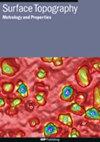Corrosion behavior analysis and characterization of AA7178 matrix alloy reinforced with nano TiO2 particles
IF 2
3区 材料科学
Q2 ENGINEERING, MECHANICAL
引用次数: 0
Abstract
The objective of this study is to assess how AA7178 matrix-based nanocomposites’ microstructure and corrosion properties are affected by the addition of nano TiO2 particles. The AA7178 alloy reinforced TiO2 composites were manufactured via stir-casting, with the TiO2 reinforcement levels ranging from 0% to 3% by 1% increments. A uniform distribution of TiO2 nanoparticles(2 wt%) over the Al matrix was shown by scanning electron microscopy analysis. The electrochemical behaviour of the base alloy matrix and surface composites was thoroughly investigated in a solution containing 3.5% sodium chloride utilizing open-circuit potential (OCP), potentiodynamic polarization, and electrochemical impedance spectroscopy (EIS). Research using polarization and EIS showed that the nanocomposites were more resistant to corrosion than the matrix alloy. Subsequent examination indicated that the increased resistance to corrosion observed in the composites containing TiO2 particles might be a result of electrochemical decoupling between the AA7178 matrix alloy and the TiO2 particles. In order to stop the corrosion from spreading, this decoupling action is vital since it protects the TiO2 particles from the matrix alloy. The composite material AA7178/2 wt% TiO2 showed the best corrosion resistance, with ideal values for potential corrosion (−0.20622 V) and current density corrosion (0.00344 mA cm−2). The main causes of corrosion were shown to be pitting and cracking by scanning electron microscopy (SEM) study, highlighting the usefulness of TiO2 in reducing these negative impacts. This work illuminates the corrosion behaviour of AA7178/TiO2 nanocomposites and emphasizes the importance of electrochemical decoupling in improving the corrosion resistance of advanced materials.用纳米 TiO2 粒子强化 AA7178 基体合金的腐蚀行为分析与表征
本研究旨在评估 AA7178 基体纳米复合材料的微观结构和腐蚀性能如何受到纳米 TiO2 粒子的影响。AA7178 合金增强 TiO2 复合材料是通过搅拌铸造制造的,TiO2 的增强水平从 0% 到 3%,以 1% 为增量。扫描电子显微镜分析表明,TiO2 纳米颗粒(2 wt%)在铝基体上分布均匀。在含有 3.5% 氯化钠的溶液中,利用开路电位(OCP)、电位极化和电化学阻抗光谱(EIS)对基合金基体和表面复合材料的电化学行为进行了深入研究。利用极化和 EIS 进行的研究表明,纳米复合材料比基体合金更耐腐蚀。随后的研究表明,在含有二氧化钛颗粒的复合材料中观察到的抗腐蚀性增强可能是 AA7178 基体合金与二氧化钛颗粒之间电化学解耦的结果。为了阻止腐蚀扩散,这种去耦作用至关重要,因为它可以保护二氧化钛颗粒免受基体合金的腐蚀。AA7178/2 wt% TiO2 复合材料显示出最佳的耐腐蚀性,其电位腐蚀值(-0.20622 V)和电流密度腐蚀值(0.00344 mA cm-2)均为理想值。扫描电子显微镜(SEM)研究表明,腐蚀的主要原因是点蚀和开裂,这突出表明了 TiO2 在减少这些负面影响方面的作用。这项研究阐明了 AA7178/TiO2 纳米复合材料的腐蚀行为,并强调了电化学解耦在提高先进材料耐腐蚀性方面的重要性。
本文章由计算机程序翻译,如有差异,请以英文原文为准。
求助全文
约1分钟内获得全文
求助全文
来源期刊

Surface Topography: Metrology and Properties
Materials Science-Materials Chemistry
CiteScore
4.10
自引率
22.20%
发文量
183
期刊介绍:
An international forum for academics, industrialists and engineers to publish the latest research in surface topography measurement and characterisation, instrumentation development and the properties of surfaces.
 求助内容:
求助内容: 应助结果提醒方式:
应助结果提醒方式:


